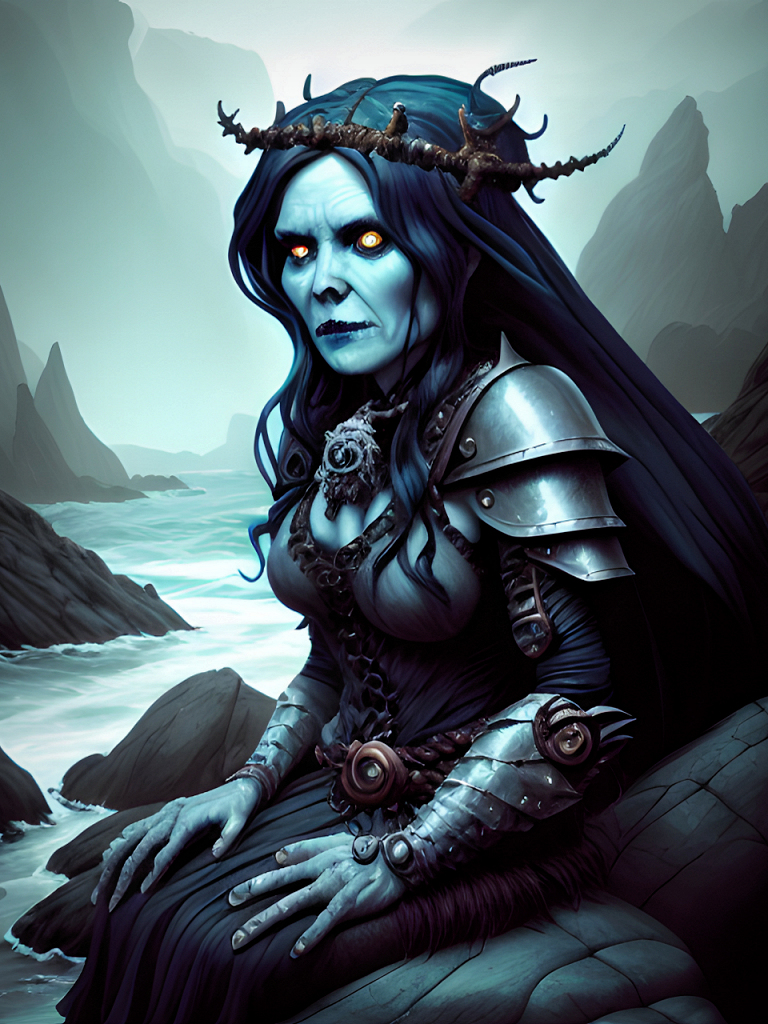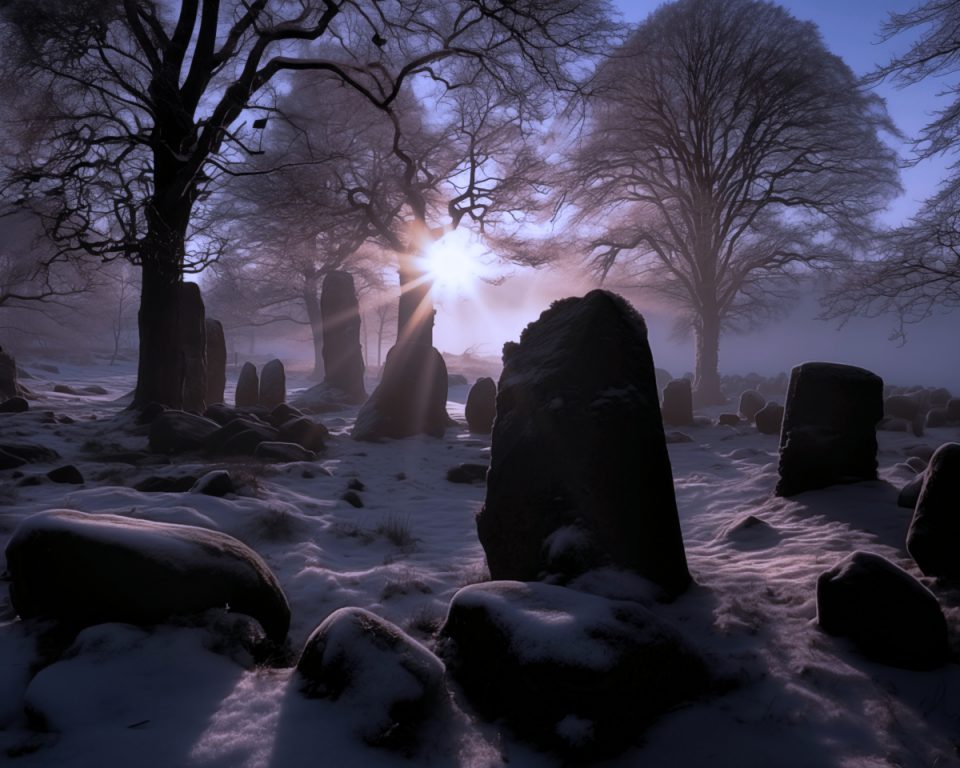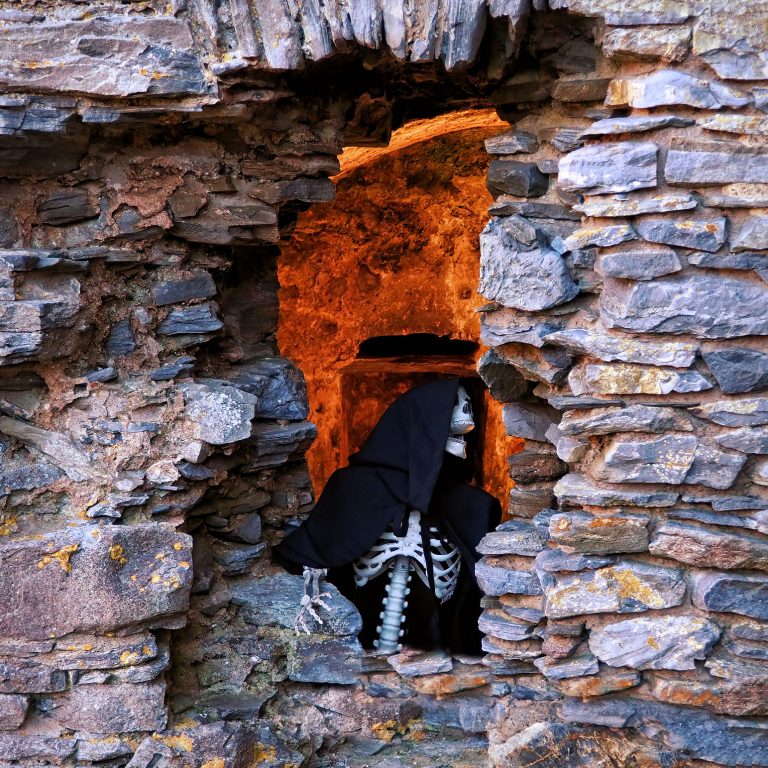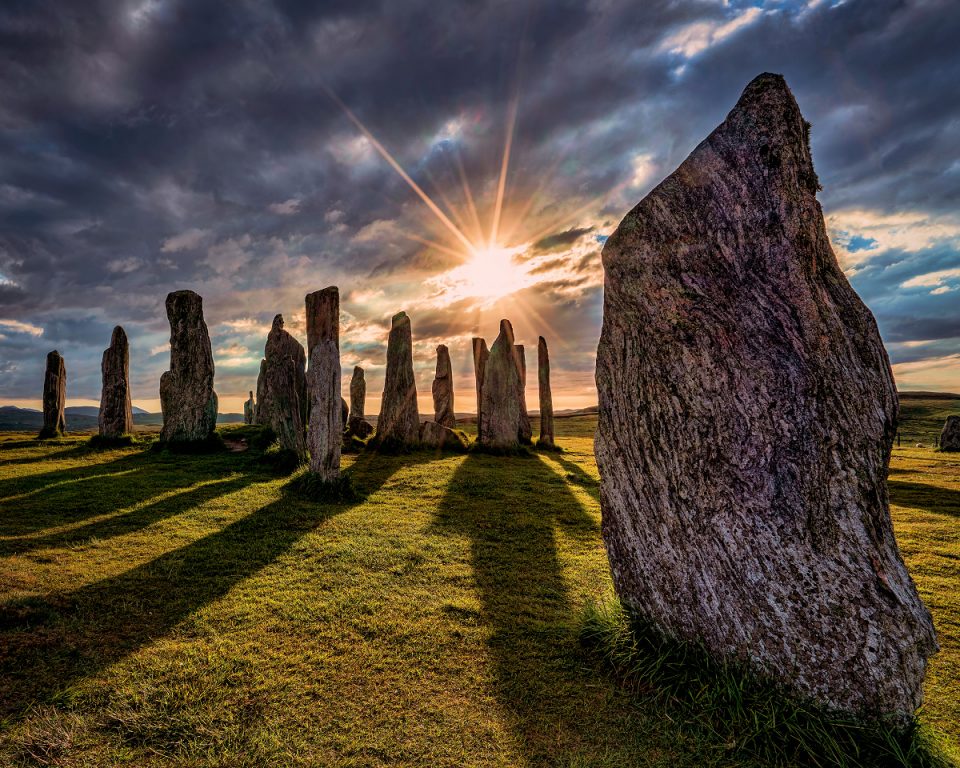Grin Iron Wife lies waiting. Sometimes she waits on the skerries, sometimes she lurks on cliffs and hides in the caves. She bides her time, waiting for the unsuspecting children and the elderly, who wander or swim too far from safety.
She is old! Ancient! And there are those who claim she can still be seen today!
Grin Iron Wife, the Sea witch of Hopeman
In the wee fishing villages along the Moray coast, tales are told of a sea witch who comes out on cold nights and lures the elderly and the young children back to her underwater cave, where she drowns her victims. She leaves a partan (crab) on the shoreline and the poor unfortunate finder will discover that they or their kin, will become her next target.
Sometimes she waits on the rocks off Hopeman’s East Beach, where the children come to swim in the gentle waters of the bay, known as Sheepies Loch. But beware- those who venture too far are caught in her snare and dragged under.
A Shore where the Ancients Worshipped
So how did the legend begin? It is hard to tell. People have lived in this area since before the dawn of recorded time. The coastline from Hopeman to Covesea is riddled with sea caves. These caves fascinated the ancient peoples of the area. This subterranean world was a luminal place, a place of transitions where the world of mortals met with the Otherworld, the realm of gods, demons, and the spirits of the ancestors. It was where the fringes of the habitable world met with the sea. Here was a meeting of both light and dark. It was here during the Bronze Age that they began to lay out the bones of their dead kin.
One of the caves was infamous! Once, racks of children’s skulls had been displayed near the mouth of Sculptor’s Cave. Those who came after, would talk of ritual sacrifice. Later, in Pictish times a ritual beheading did take place in the cave but it seems likely that grieving parents carried the tiny bodies of their children to the cave as an offering to their Gods so their short lives would be remembered.
A Solstice Connection
Perhaps it is significant that at Hopeman that on the east side of Sheepies Loch two rocks jut into the sea. These are Daisy and the Hive Rocks. The Summer solstice aligns directly with the notch between the two rocks. We know that from Neolithic times, the early peoples were obsessed with the solstices. They built Stone Circles and Cairns to mark these events. But here it occurs naturally.
Further East, near the Spey Estuary, a manmade monument has been raised to mark the Summer Solstice. The Browlands Stone Circle is a four-thousand-year-old four-poster circle. This is an unusual stone circle configuration for the Northeast of Scotland. But on the night of the Summer Solstice, it is easy to see why it has been arranged in this way. The two large stones mirror two of the Highland mountains on the other side of the firth. The smaller stones mirror the dip between the two mountains. They are aligned to the spot where the solstice sun dips below the horizon. Thus, we know there were people living nearby in early times who were watching the solstices and that this likely formed part of their worship.
On the hill above Daisy Rock is a spring, once revered as a sacred well, known for its sacred properties- the Braemou Well. Could it be that The Grin Iron Wife had her origins not as a witch but as a folk memory of a long-forgotten Goddess, once venerated by the early peoples who settled in the area?
The Origins of The Grin Iron Wife
The origins of Scotland’s myths and legends are complex and often shrouded in mystery. Some are remnants of the old religions that predate Christianity. Some were the ways that the early people of Scotland explained the world they lived in. For instance, the story of Bride and the Cailleach was once used to explain the passing of the seasons. Some are cautionary tales, warnings to the vulnerable of the dangers that might await them in the forest or the depths of the sea. Don’t go in the woods or the big bad wolf will eat you or the fairies will carry you away. Don’t go near the river, a kelpie might capture you.
It is possible that the legend of the Grin Iron Wife began as a cautionary tale. Sheepies Loch is a relatively safe place to swim. But for the emboldened, swimming beyond the safety of the shallows could result in them being pulled out to sea as they encountered the current beyond in the deeper, further reaches of the Loch.
It also might have been a rumour put about to stop certain people in the community from telling what they might see when there were smugglers in the vicinity.
How Hopeman got its Name?
William Young ‘founded’ the village of Hopeman in 1805. He saw that the area had potential as a fishing village. This was the time of the Highland Clearances with the result that a large, mostly Gaelic-speaking community were reduced to squatting on his land. This formed the basis of Hopemen as we know it today.
However, long before this, there was a settlement there called Haudment or Howdment. People from Howdment were buried at Saint Peter’s Kirkyard in Duffus as far back as the late 1600s.
The origin of “The Haudment,” took its name from the activities of French Smugglers who were active in the area. French sailing luggers carried illicit goods, in particular wines and brandies. During the final leg of the journey the crew became vigilant, looking for large rock, known as the Tappach of Roseisle. All eyes were trained southward, and when the rock was sighted, the cry would get up, “Le Haut Mont!” (The High Hill).
At half tide, there was sufficient water to float a lugger into the nearby cove, where the cargo could be discharged and hidden in the caves. The lugger would return to France with a cargo full of Scottish wool. In time the French Landfall call was corrupted to Houdmin, then Houpman to its present-day name.
Rumours of a witch on the cliff faces would have kept the children and elderly, from seeing any illicit activities and thereby stop them from accidently revealing incriminating details to the excisemen.
Where did Grin Iron Wife Get her Name?
I am left wondering where Grin Iron wife got her name. Did she have iron teeth, like Jenny wi’ the Airn Teeth? This was a vampire like creature said to live at Carnannock Cairn, Carsphairn in Kirkcudbrightshire. The poet Alexander Anderson hailed from this area and immortalised ‘Jenny’ in his poem ‘Jenny wi’ the Airn Teeth’. The poem became popular in Glasgow and might have been a contributing factor in a mass hysteria event where the local children went out to hunt the ‘Gorbals Vampire.’
Then again could Grin Iron Wife’s name be derived from the colour of her teeth? In Donald Alexander MacKenzie’s book ‘Wonder Tales from Scottish Myth and Legend’, he describes Beira, the Cailleach as having teeth ‘as red as rust’. Rust is obviously something we associate with iron. Perhaps this takes more of a significance when we realise that the fisherfolk from the Cromarty area, on the opposite side of the Moray Firth to Hopeman, referred to the spring equinox windy weather as Gentle Annie.
MacKenzie said “Gentle Annie is feared most in the spring-time. During the rest of the year the south-west wind is ‘gentle’ enough. The Cromarty fisher-people refer to the spring equinox as ‘Gentle Annie weather.’ During that stormy period, which ‘lasts sometimes for six weeks,’ they cannot go to sea and food is very scarce. ‘We’ll have to be keeping a shilling or twa beside us for the time o’ Gentle Annie,’ a shrewd fisher-woman remarked to the Writer.” He linked Gentle Annie with the Winter Hag, Beira.
Conclusion
It is difficult to find much information about Grin Iron Wife. Is she a witch, ghost or the folk memory of an ancient Goddess. Is it possible that Grin Iron Wife is another manifestation of the Cailleach, Beira, Goddess of Winter?




